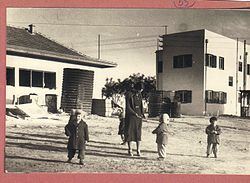District Northern Affiliation Kibbutz Movement Website www.sarid.org.il Local time Wednesday 9:37 PM | Council Jezreel Valley Population (2015) 851 Founded 1926 | |
 | ||
Founded by Eastern European immigrants Weather 13°C, Wind NW at 2 km/h, 82% Humidity | ||
Kibbutz sarid ulpan 1975 a personal experience
Sarid (Hebrew: שָׂרִיד) is a kibbutz in northern Israel. Located near Migdal HaEmek, it falls under the jurisdiction of Jezreel Valley Regional Council. In 2015 it had a population of 851.
Contents
- Kibbutz sarid ulpan 1975 a personal experience
- Map of Sarid Israel
- Ottoman era village of Khanfis
- The Arab village
- The kibbutz
- Economy
- Notable residents
- References
Map of Sarid, Israel
Ottoman-era village of Khanâfis
During the Ottoman era a Muslim village called Ikhneifis (also Khanâfis and other versions), meaning "beetles", stood at the site of present Sarid. Kneffis, and the neighbouring towns and villages of Nazareth, Mejdal, Yafa, Jebatha and Ma'alul, paid taxes to the monks of Nazareth, who bought the right to collect these taxes from the Ottoman authorities in 1777 for two hundred dollars. Thirty years later, they again purchased this right, though this time for two thousands five hundred dollars, owing to the rise in the price of cereals and ground rents. A map from Napoleon's invasion of 1799 by Pierre Jacotin showed the place, named as Karm Ennefiiceh.
In 1882, the Palestine Exploration Fund's Survey of Western Palestine (SWP) found at Ikhneifis the "ruin of a tower built by Daher el-Omar about a century ago (1162 A.H.)." Gottlieb Schumacher, as part of surveying for the construction of the Jezreel Valley railway, noted in 1900 that Ikhneifis was a “flourishing village”, consisting of 52 huts and 230 inhabitants, and that the place was the property of the Sursocks, of Beirut.
Moshe Dayan mentioned it as an example of "there is not one place built in this country which did not have a former Arab population".
The Arab village
At the time of the 1922 census of Palestine "Ikhnaifes" had a population of 39, 38 Muslims and 1 Orthodox Christian.
The kibbutz
The kibbutz was established by immigrants from Czechoslovakia, Poland and Russia in 1926, on lands purchased from the village of Khuneifis. The land was sold by the Sursock family, its absentee landlords. The name was taken from the biblical city of Sarid, situated in the southern part of the tribe of Zebulun (Joshua 19:10). The ancient city is thought to be located in nearby Tel Shadud. By the 1931 census, Sarid had a population of 69, 3 Muslims and 65 Jews, in 9 houses.
Economy
In the 1950s the kibbutz established Camel Grinding Wheels (CGW), which now has three plants for the manufacture of cutting discs, grinding wheels and coated abrasives. One of the more profitable branches was the kibbutz dairy.
Notable residents
The poets Natan Yonatan and Pinchas Sadeh and the politicians Natan Peled and Shlomo Rosen were members of the kibbutz.
